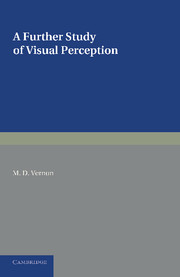Book contents
- Frontmatter
- Contents
- List of Illustrations
- Acknowledgements
- Chapter I INTRODUCTION
- Chapter II THE NATURE OF PERCEPTION
- Chapter III THE PERCEPTUAL PROCESS
- Chapter IV THE DETERMINATION OF FORM
- Chapter V SPATIAL PERCEPTION
- Chapter VI THE CONSTANCIES
- Chapter VII THE FUNCTIONS OF THE FRAMEWORK IN PSYCHO-PHYSICAL EXPERIMENTS
- Chapter VIII THE PERCEPTION OF MOVEMENT
- Chapter IX MICHOTTE'S STUDIES OF SOME INTRINSIC PHENOMENA OF EXPERIENCE
- Chapter X THE INFLUENCE OF INTERNAL AND INDIVIDUAL FACTORS UPON PERCEPTION
- Chapter XI CONCLUSION
- Appendix A
- Appendix B
- References
- Index of Authors
- Index of Subjects
- Frontmatter
- Contents
- List of Illustrations
- Acknowledgements
- Chapter I INTRODUCTION
- Chapter II THE NATURE OF PERCEPTION
- Chapter III THE PERCEPTUAL PROCESS
- Chapter IV THE DETERMINATION OF FORM
- Chapter V SPATIAL PERCEPTION
- Chapter VI THE CONSTANCIES
- Chapter VII THE FUNCTIONS OF THE FRAMEWORK IN PSYCHO-PHYSICAL EXPERIMENTS
- Chapter VIII THE PERCEPTION OF MOVEMENT
- Chapter IX MICHOTTE'S STUDIES OF SOME INTRINSIC PHENOMENA OF EXPERIENCE
- Chapter X THE INFLUENCE OF INTERNAL AND INDIVIDUAL FACTORS UPON PERCEPTION
- Chapter XI CONCLUSION
- Appendix A
- Appendix B
- References
- Index of Authors
- Index of Subjects
Summary
At the beginning of this book we stated that the percept does not mirror the exact stimulus conditions of the external world, nor is it completely determined by the sensations passing from the sense organs to the central nervous system. The truth of the statement has been amply demonstrated by the experimental data described in the book. We have seen that patterns of visual, tactile, and kinaesthetic sensations are perceived as solid objects having an enduring existence. These perceived objects exert an inclusive influence on their constituent parts, but appear sharply delimited and isolated from one another. And these two qualities of inclusiveness and delimitation appear also in representations of objects, and even in simple shapes, at least to adult observers.
Further, it was postulated that these qualities of the constituents of the external world were constructed from the primary sensory data in the course of the perceptual process, in order that the observer might preserve as far as possible the appearance of stability, persistence, and consistency of the environment; and hence be able to understand it, and know how to react to it satisfactorily. In doing this, it was essential for him to be able to differentiate between what was familiar, well-known, and enduring, and what was new, unexpected, in rapid change, potentially important, or harmful. Thus he set up for himself a numerous and complex arrangement of ‘schemata’—ways of apprehending and reacting to particular classes of situation. These schemata, although possibly possessing some innate basis in instinctive needs or temperamental peculiarities, were developed largely during the course of the individual's life-time. Any perceptual situation encountered could then be fitted into its appropriate schema or chain of schemata, by virtue of the ‘effort after meaning’, until it was understood and reacted to in the most satisfying and effective manner.
We have described types of schematized reaction: to permanent and stationary objects, representations of objects and shapes; to changes of appearance of objects with change of position; to moving and inter-acting objects; to the position and movement of the body in relation to surrounding objects.
- Type
- Chapter
- Information
- A Further Study of Visual Perception , pp. 257 - 259Publisher: Cambridge University PressPrint publication year: 2013



